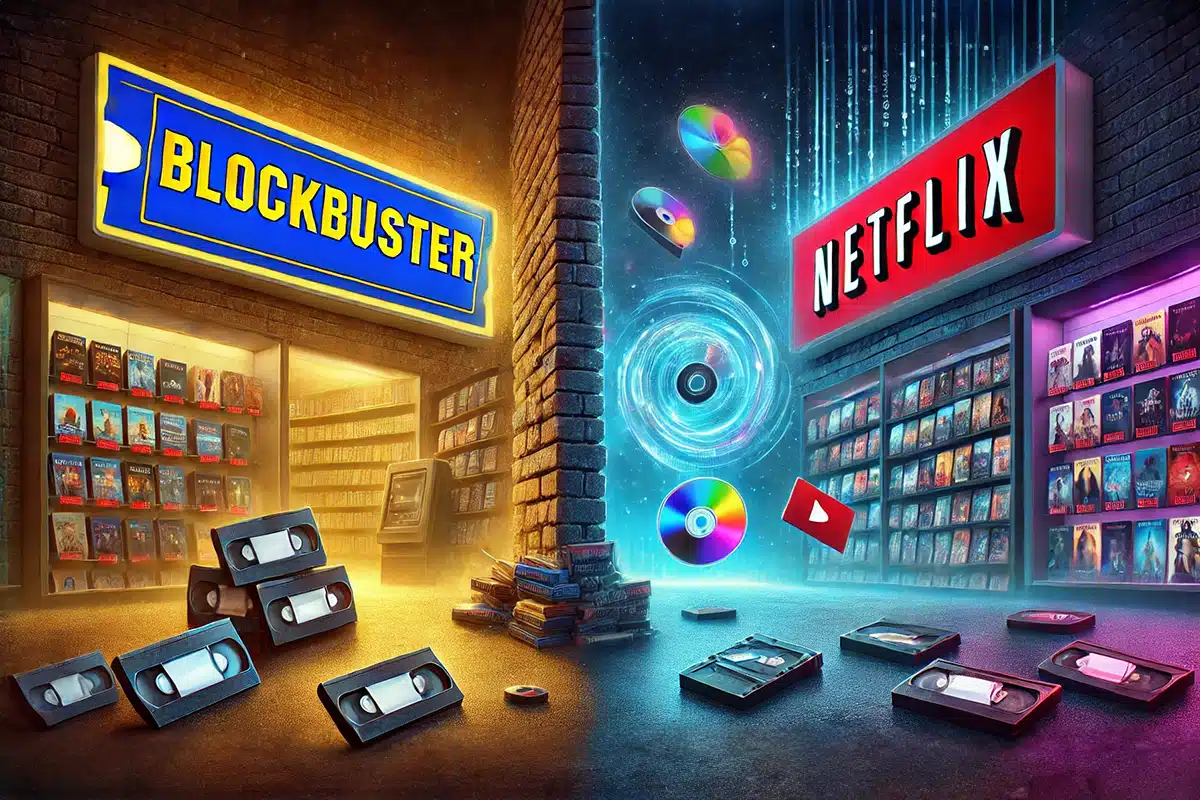
When you look over recent chapters in business history, few stories are as emblematic of technological disruption and strategic missteps as the rise of Netflix and the fall of Blockbuster. Once a titan of the home entertainment industry, Blockbuster’s downfall serves as a cautionary tale of what happens when a company fails to adapt to changing consumer behaviors and technological advancements.
The Golden Age of Blockbuster
Founded in 1985, Blockbuster quickly grew to become the largest video rental chain in the world. By the early 2000s, the company boasted over 9,000 stores globally and a ubiquitous presence that made it synonymous with Friday night movie rentals. Blockbuster’s business model was pretty straightforward. Customers would visit a store, rent a VHS tape or DVD, and return it after a few days. The later, the better for Blockbuster because late fees were a significant revenue stream that contributed to their profitability.
However, beneath this veneer of success, cracks were beginning to show. The rise of digital technology and the internet was about to revolutionize the way people consumed media, and Blockbuster was ill-prepared for the oncoming storm.
The Emergence of Netflix
Netflix was founded in 1997 by Reed Hastings and Marc Randolph. Initially, the company operated as an online DVD rental service, allowing customers to rent DVDs by mail. For a monthly subscription fee, users could choose movies from an online catalog and have them delivered directly to their mailbox. This model eliminated the inconvenience of traveling to a physical store and the dreaded late fees that were a staple of Blockbuster’s business.
Netflix’s true innovation, however, came in 2007 when it introduced a streaming service that allowed subscribers to watch movies and TV shows directly over the internet. This shift marked the beginning of a new era in home entertainment, one that prioritized convenience and on-demand access to content.
Blockbuster’s Missed Opportunities
Blockbuster had several opportunities to pivot and compete with Netflix, but a series of strategic missteps sealed its fate. In 2000, Reed Hastings approached Blockbuster with an offer to sell Netflix for $50 million. Blockbuster’s executives laughed off the proposal, failing to recognize the potential of the nascent company and the shift towards digital media consumption.
Even as Netflix began to gain traction, Blockbuster was slow to respond. It wasn’t until 2004 that Blockbuster launched its own online rental service, but by then, Netflix had already established a strong foothold in the market. Blockbuster’s attempt to integrate online rentals with its physical stores created a confusing and inefficient system that failed to resonate with consumers.
Moreover, Blockbuster’s reliance on late fees continued to alienate customers, while Netflix’s subscription model, which eliminated late fees entirely, became increasingly attractive. Blockbuster did eventually remove late fees in 2005, but it was too late to slow the pace of its downfall.
The Decline and Fall
As Netflix continued to innovate and expand its streaming library, Blockbuster struggled to keep up. The financial crisis of 2008 dealt another severe blow to the already struggling company, and Blockbuster was forced to file for bankruptcy in 2010. Its remaining stores were gradually closed or sold off, with the last company-owned store shutting its doors in 2014.
In contrast, Netflix continued to evolve and grow exponentially. The company shifted its focus to original content production, creating critically acclaimed shows like House of Cards and Stranger Things, which further cemented its dominance in the entertainment industry. Today, Netflix is a global powerhouse with more than 200 million subscribers and a market value in the hundreds of billions.
Lessons Learned
The story of Blockbuster vs. Netflix is more than just a tale of corporate rivalry. It is a lesson in the importance of innovation, adaptability and understanding consumer needs. Blockbuster’s failure to recognize and adapt to the digital revolution allowed Netflix to disrupt the industry and redefine how we consume media.
In an ever-evolving technological landscape, businesses that remain vigilant and agile like Netflix are ready to pivot and embrace new models that better serve their customers. The rise of Netflix and fall of Blockbuster serves as a consequential reminder that in the world of business, complacency can be your greatest enemy.
Resolution Promotions is in no way affiliated with Blockbuster, Netflix or their subsidiary partners. This blog post is simply a historical review from a business and marketing perspective.



